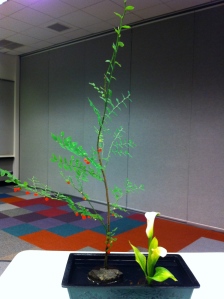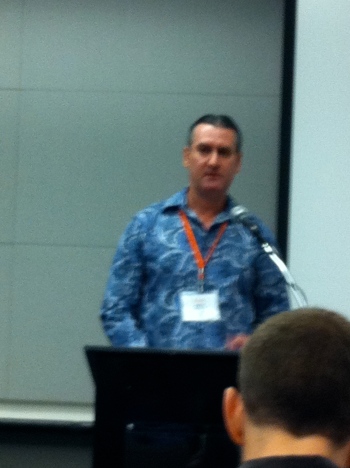In the last installment of this thrilling diary, as you may recall, we left our heroes at a bar in the small hours of the morning. After the small hours of the morning, I’m sure you’re aware, come the large hours of the morning, and if you haven’t slept very much in between the small hours and the large hours, the large hours can be very painful.
All this is by way of excuse for my missing the first event of Saturday morning, a panel discussion by Maggie Chula, Penny Harter, Jerry Ball, and Garry Gay called, “Who Wrote That? How My Haiku Has Changed Over Three Decades.” I heard from reliable reporters that it was a fascinating discussion, but I don’t think I would have enjoyed it while holding my head and moaning. To distract you from the fact that I have nothing to report from this session, I will now present some placeholding Pretty Pictures from Around the Conference.
Great ikebana, eh? Beautiful courtyard sculpture. Now what were we talking about?
… Oh yes. The second session of the morning. Of many tempting options I chose to attend Paul Miller‘s talk on “Stretching Western Haiku (Gendai Haiku in the West).” The question Paul posed to us was, “How far can you stretch haiku and still consider it haiku?”
I’m not sure he or any of us came to a definitive conclusion on this, but Paul did an excellent job of analyzing Japanese gendai haiku and dividing it into some broad categories, including: Haiku that are metaphors or similes; Haiku that are “fantastic transformations” (in the “fantasy” or surreal sense of the word) where one object turns into another in a way that is impossible in real life; Haiku that are “fantastic metaphors”; Haiku that are “just fantastic”; Haiku that directly tell; Haiku that are “private discourse,” depending on associations known only to the author; and Haiku that contain abstract language. In Paul’s estimation, only the second, third, and fourth categories are really effective as haiku. Here’s one from category two that most of us really liked:
After a heated argument
I go out to the street
and become a motorcycle.
— Kaneko Tota
I might not place all Paul’s examples into the same categories he did, I might not have the same categories, and I might not have the same opinions about which haiku and which categories are effective. But as he said, this is just a place to begin thinking and talking about gendai and how it works. There will certainly continue to be endless discussion in the years to come.
…And oh yeah. Charlie Trumbull didn’t announce this until later in the day on Saturday, but here would probably be a good place to report that Paul will be the next editor of Modern Haiku, starting in the spring of 2013. Congratulations to him. Here he is (he’s not this blurry in real life):
Shortly after this session ended we were all shooed in the direction of the Space Needle (a few blocks from our convention center) for the HNA banquet. You know how banquets work, right? You have them in landmark buildings in rooms with spectacular views … no, wait. Usually you have them in dark, dull hotel banquet rooms with no windows. Thanks to the HNA planning committee for making ours more interesting.
We did have some more normal banquet features, such as banquet tables that everyone takes an endless time to get settled at because they’re all busy talking to each other.


 Also, a charity auction with a highly entertaining auctioneer who is also a haiku poet, named David Ash. It was called an Unsilent Auction because mostly it was a silent auction except for the part where David was talking. If you see what I mean.
Also, a charity auction with a highly entertaining auctioneer who is also a haiku poet, named David Ash. It was called an Unsilent Auction because mostly it was a silent auction except for the part where David was talking. If you see what I mean.
Silently, I won (by cleverly bidding four dollars over the cover price) a copy of John Martone’s Ksana, which I have wanted since the moment I first heard it existed. No, you can’t borrow it.
… Oh yes. And what haiku conference would be complete without a visit from Elvis?
Not HNA, that’s for sure. That’s Carlos Colon all dressed up there (with HNA volunteer and organizer extraordinaire Katharine Hawkinson). Without video or audio I cannot fully convey to you the brilliance of Carlos’s performance as Haiku Poet Elvis. There were many hardened poets laughing so hard that tears came to their eyes and they nearly needed to be resuscitated. If I hadn’t been laughing so hard myself I would have written down Elvis’s entire haiku repertoire, which amounted to several dozen poems, but here are a couple I managed to control myself long enough to record. These were all interspersed with appropriate Elvis-like patter. Again, it had to be seen to be believed.
Lily…
out of the water
out of her suit
jailhouse rock
it bounces off the head
of a heckler
— Carlos Colon (“Elvis”)
Carlos was a tough act to follow but unfortunately I had to follow him. Not just me, of course — me, Fay Aoyagi, Gene Myers, and Don Wentworth, who had to hustle down from the Space Needle and get back to the conference center for our presentation on Haiku Blogging. We were delayed a bit waiting for the audience members who were still in the elevator trying to get off the top of the Needle. Still, we had a fairly entertaining discussion and not a bad crowd at all considering most of them were still trying to digest banquet food and the amazing spectacle of Carlos Colon as Elvis. I don’t have any pictures, sorry, I forgot to give my phone to anyone to record me for posterity. (There are some pictures floating around Facebook, though, if you hang out there in haiku circles. I look like a tired, short woman sitting at a table.)
Far more interesting was the next presentation, by Eve Luckring, on “Video Renku: Link and Shift in Visual Language.” Eve is a photographer and filmmaker as well as a highly original haiku poet. She began by discussing the film technique of Sergei Eisenstein, including his theory of “montage” and the different visual effects that could be used by filmmakers to evoke different emotional responses. We saw numerous clips from Eisenstein films such as “Battleship Potemkin.”
Then, brilliantly, Eve drew parallels with these montage techniques and the linking techniques used in renku, such as word association and the elusive concept of “scent.” When our minds had been sufficiently blown by this comparison, she introduced an exercise: Giving us all prints of photographs, she asked us to write a renku link to them, concentrating primarily not on the subject matter of the photograph but on its visual elements (see below for Eve’s slide describing these).
It’s difficult to explain without presenting these photographs exactly how this exercise worked or how brilliantly compelling it was, but when I get home I am going to do some more of this. I found it really worked to knock loose unusual images and unexpected comparisons from my mind. This was one of my favorite presentations at the conference.
After this, I found myself once again compelled by exhaustion to miss a couple of events I would have loved to have seen and heard excellent reports of later — the folk music of La Famille Leger (Dejah Leger and her husband), and Terry Ann Carter‘s presentation on the history of haiku in Canada.
Instead, I went off and had a bite in the hotel courtyard and breathed for a while, and then came back to hear Charlie Trumbull‘s fascinating, comprehensive talk on the history of haiku in English. Can you say “forty-eleven well-designed PowerPoint slides accompanied by a well-structured, erudite, but eminently listenable speech that all must have taken Charlie the better part of forever to put together”? I thought so.
Here’s one of his slides pointing out the effect that the writings of Thoreau and Emerson had on early haiku poets in English. Obviously. Duh. I knew that.
I was especially grateful for Charlie’s presentation during the next event of the evening. It was a “Haiku Bowl,” created and moderated by Charlie and Jim Kacian, and featuring two teams facing off, striving to win glory and honor by answering questions about haiku history. The Frog team featured contestants Eve Luckring, Michael Dylan Welch, David Lanoue, and Fay Aoyagi and the clacking alligators they used to signal when they knew the answer to a question. The Bird team featured contestants Emiko Miyashita, Cor van den Heuvel, Richard Gilbert, me, and our bird whistles. (I would just like to state for the record that it takes longer to produce a sound with a bird whistle than an alligator clacker.)
Mostly I sat back in amazement while the other Birds and the Frogs brought forth all kinds of obscure haiku knowledge from the depths of their powerful brains. When I knew the answer to something, it was usually because everyone did. We were all greatly helped, though, by having just attended Charlie’s lecture. Our team was further assisted by having one of the questions be “What was the title of Cor van den Heuvel’s first published book?”
It was a fun, light-hearted contest and the two teams took turns being in the lead, ending with an elegantly arranged near-tie. Okay, technically the Frogs won, but only because they had a better idea of what the population of Livermore, California is. Don’t ask. But we all had a great time, and we also all got prizes. The Frogs got a box of flies and the Birds got a box of worms.
See?
This rip-roaring pseudo-entertainment was followed by some real entertainment by talented people — La Famille Leger once again, providing the music for a square dance. It looked the kind of thing that would be great fun if you weren’t ready to topple over with exhaustion. So I stuck around to take a few pictures and then went back to the hotel. Where I stayed up too late blogging. But hey! At least I hadn’t had any fun square dancing!
… And that was the end to the official conference-type activities of Haiku North America 2011. Coming tomorrow: The official tourist-type activities of Haiku North America 2011. Featuring fog, panting hikers, totem poles, and salmon. Don’t miss it.














